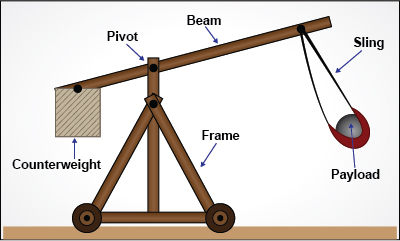Project 2016: Optimizing a Medieval Siege Engine
This year's project will be aimed an using Lagrangian mechanics to understand a medieval marvel of engineering; the trebuchet.

A counterweight trebuchet, a medieval compound machine. Students in this class have to build a small trebuchet demonstrate that it works. (Image by MIT OpenCourseWare.)
Note 1
Do this project alone and without a computer or the internet, though you may use textbooks, lecture notes, pset solutions, etc. I have encouraged you to work together on the psets, and there is no exam in this class, so here I want to see what you can do on your own. Part 2.1 (Experimental) is an exception, in which you may work in small groups (3 or less) and use the internet for design and construction examples. For part 2.2 (Numerical) you are clearly expected to use your computer.
When writing your answers, you must simplify as much as is reasonable. For instance, you should: Divide out common factors, combine mass X length terms with common trigonometric pre-factors, etc. Also, when writing equations of motion, put the second derivative of the coordinate you are solving for on the left hand side of the equation, and everything else on the right (see part 1.5 for an example). All of this is designed to make sure that I can easily identify correct answers without Mathematica or a magic decoder wheel.
Note 2
Grading 100 projects in a day or 2 will not be easy, so please turn in your project as soon as it is done. To add an incentive to this plea, I will give 3% extra credit for each day before the due date that you turn in your project, with a maximum of 30%.
